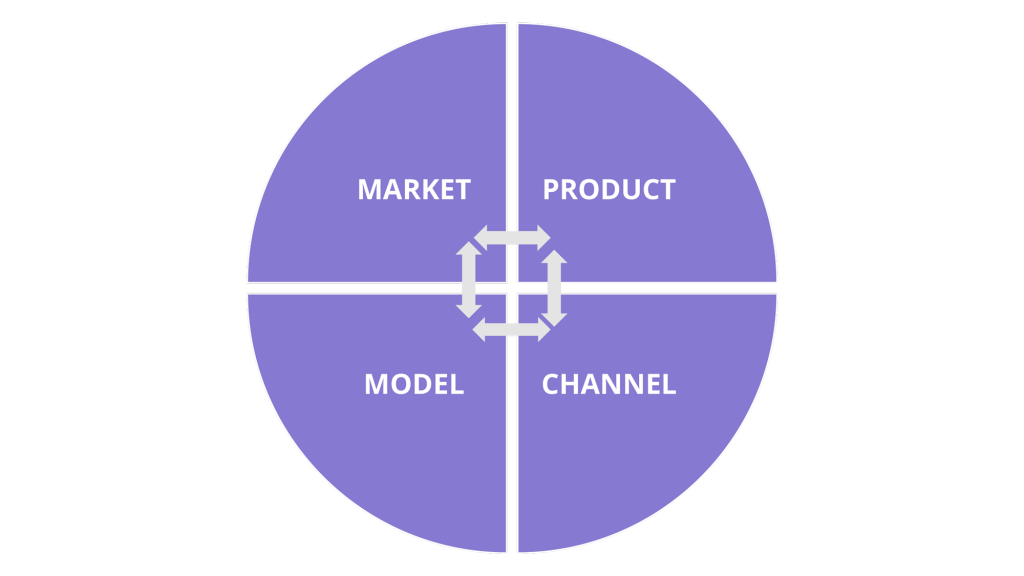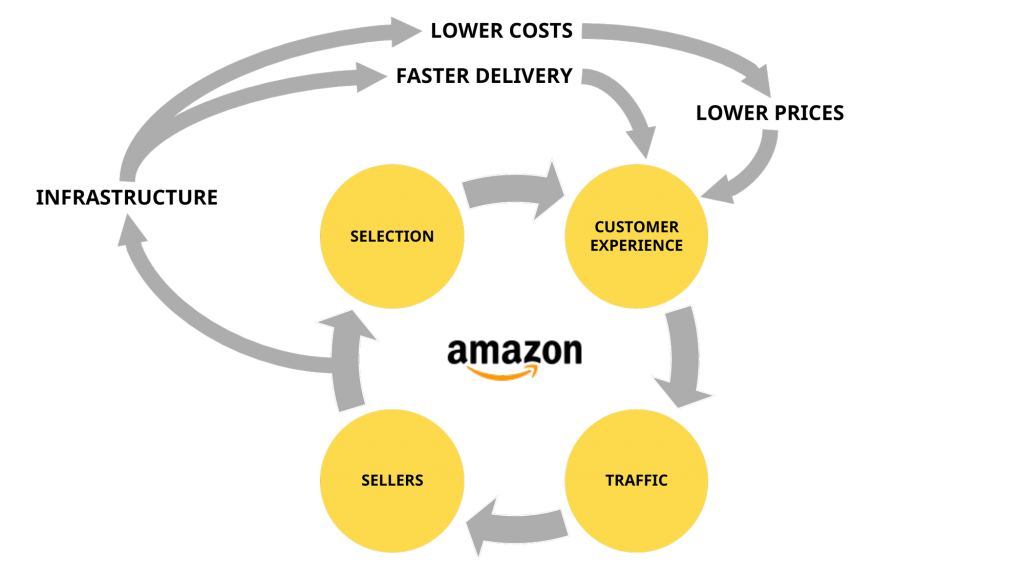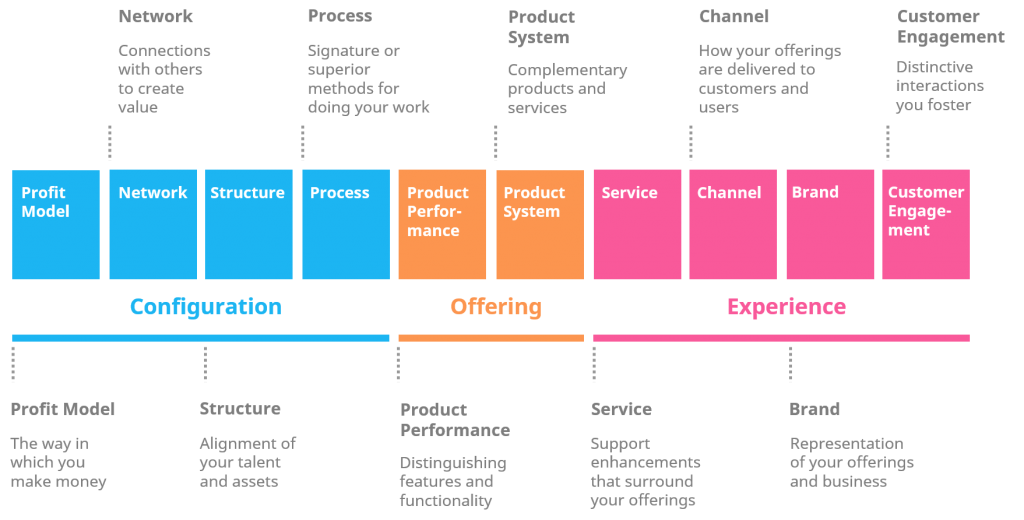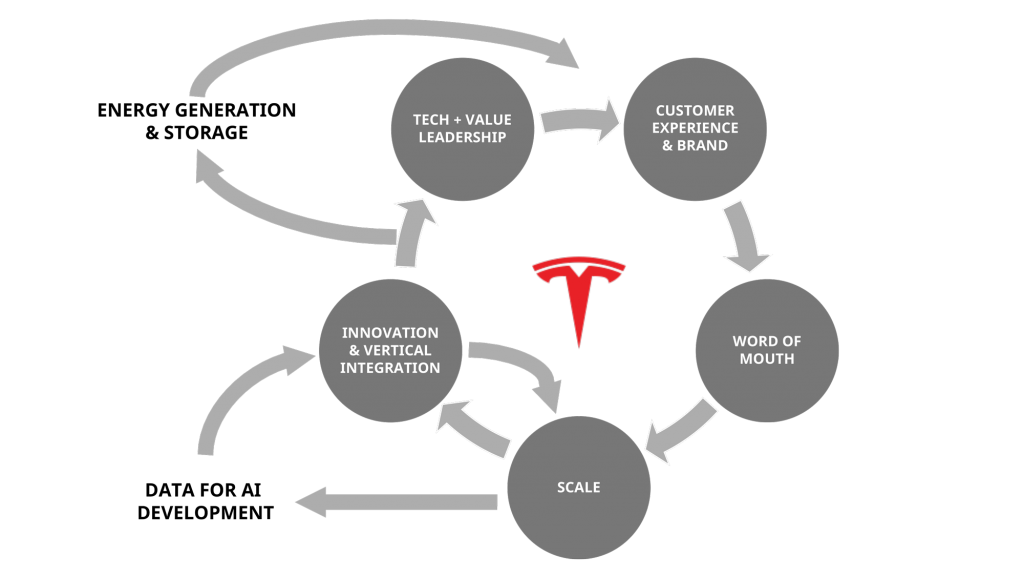The Flywheel of Growth – A Strategic Innovation Framework
These days virtually everyone agrees that innovation is strategically important. For example, in an international PwC innovation survey of roughly 250 CEOs, only 3% said that innovation is not a strategic priority for them.
Regardless of these results, organizations often struggle in aligning their innovation efforts with their overall strategy.
On the other hand, top performing innovators always seem to have a clear focus in their innovation work, which naturally comes from having clear strategic priorities that are well-aligned with the overall corporate strategy.
Today we’ll be focusing on a concept that I’ve personally found to be a tremendously helpful framework for bridging this gap, as well as for communicating these strategic priorities to key stakeholders: The Flywheel of Growth.

What is the Flywheel Effect?
The Flywheel Effect was first introduced by Jim Collins in his classic book, Good to Great.
The key idea is that good companies don’t just suddenly become great companies overnight. There isn’t a single defining moment or a magical event responsible for that success.
It is, instead, a gradual process that takes plenty of time, hard work, and deliberate action towards the eventual destination.
The metaphor is that it’s just like turning a really heavy flywheel. At first, it barely moves. But when you keep pushing it, the effort eventually overcomes the inertia. Push by push, the wheel starts accelerating more, until a point where the momentum eventually takes over.
What makes it such a great metaphor for business success is that it’s able to capture both the struggle in getting things off the ground, but also the very essence of strategy and competitive advantage.

That is, to gain a sustainable competitive advantage, you need to build a system where all of the parts fit together to create something with so much momentum that it’s practically unstoppable.The mistake many people make is that they expect a single big project, innovation, or product launch to change everything. In reality, that often barely nudges the Flywheel if the rest of the pieces aren’t in place.
Getting a Flywheel up to speed takes a very focused and systematic approach, as well as plenty of time. In essence, you first need to build the pre-requisites before breakthrough success is possible.
Getting a Flywheel up to speed takes a very focused and systematic approach.
What’s more, a Flywheel is also an elegantly simple visualization that can help solve the age old problem of making the answer to the question of “how do we win?†obvious for everyone in your organization.
After all, according to research, as few as 5% of employees are actually able to understand their corporate strategy. There are many reasons for that, but the biggest one is usually that no one’s managed to boil it down to the essentials so that people would “get it” right away.
Applying the Flywheel to innovation
The Flywheel, obviously, isn’t specific to innovation. Still, innovation always plays a big role in building the Flywheel, which is why it can be a very simple, yet practical framework for thinking about innovation as a strategic pursuit.
Let’s first take a look at what it takes to actually build one.
A Flywheel doesn’t just appear, it needs to be built
If you’ve spent any time with startups or VCs, you’ve likely heard a lot of talk about Product-Market fit.
In essence, one of the common failures for new products in both startups and large organizations alike is that the product doesn’t simply have strong enough market demand.

On the contrary, if you are able to achieve a strong Product-Market fit in a great market, you’re almost guaranteed to build a solid business out of it. Suffice to say, pursuing a Product-Market fit should be a huge priority for every innovator.However, if we look at any of the very best companies, the ones with the biggest and most sustainable competitive advantages, there’s obviously a lot more to it than just Product-Market fit.
They don’t just have a great product for a great market. They also have a solid business model and the right channels for selling and delivering their products.
You also need the right organizational structure and operating model for actually being able to achieve the aforementioned. In a startup, these are often more or less a given, but in a large organization, these can end up hindering or blocking progress.
Brian Balfour has written about this topic in length in his excellent series of articles on finding Product-Market-Model-Channel fit.

The bottom-line? You can’t just build a Flywheel out of thin air if the building blocks aren’t there.
You can’t just build a Flywheel out of thin air if the foundations of a solid business simply aren’t there.
On the other hand, once you’ve put all of these pieces together, you actually end up with something that’s much more than the sum of its parts.
As Balfour puts it, companies that are able to achieve this can grow incredibly fast seemingly effortlessly, even if they don’t abide by all of the so-called best practices. That’s an example of a business that has all of the elements in place for a strong Flywheel.
Building a system with multiple Flywheels
So, clearly, if you can build a strong Flywheel, both you and your organization are going to be very successful.
However, the best organizations aren’t satisfied with just that. They are always looking to find and build their next Flywheels. When these individual Flywheels are aligned with one another, they become an elaborate system of self-reinforcing virtuous cycles that’s nearly impossible to stop.
A Flywheel offers an organization the time and resources needed to fix things that are broken without the whole system grinding to a halt.

Even if one of the Flywheels breaks or slows down, as every Flywheel eventually will, the momentum provided by the other Flywheels offers the organization the time and resources needed to fix the broken one without the whole system grinding to a halt.Having said that, you must also be careful not to try to move to new Flywheels prematurely. A single strong Flywheel is always far superior to multiple mediocre ones.
As Collins has well put it, the companies that never quite became great usually get bored or tired, or otherwise lacked the discipline to take the time and effort to keep pushing their Flywheel until it becomes unstoppable.
Amazon is a classic example of a company that has successfully embraced the concept of the Flywheel. As I’m sure everyone knows, they began as a simple online bookstore, albeit one with big ambitions.
Once they got off the ground, they soon expanded into other product categories and also opened the platform for third-party merchants to help drive more traffic, provide a better customer experience, as well as make the most out of their delivery infrastructure. Together, these have enabled the company to lower prices, which has again accelerated the Flywheel.

Later on, once they had already reached tremendous scale, they realized that the massively advanced IT infrastructure they’d had to build to manage their enormous scale was quite unique. They decided to start offering access to it for other companies “as a service†to further bring costs down thanks to economies of scale. This was Amazon Web Services (AWS), which now actually accounts for the majority of the company’s profits.
These profits allow the company to further improve both the core e-commerce business, as well as some of their other initiatives, such as media and services, hopefully creating the next Flywheels to their system.
This video by Simon Torrance does a great job explaining how these Flywheels work together to enable the tremendous growth we’ve seen from the company in the last decade.
What powers your Flywheel?
When you’re starting to map out your own Flywheel, it’s important to understand that there are many different kinds of Flywheels.
However, at the heart of all Flywheels are elements that inevitably follow one another, thus accelerating growth and creating strong economies of scale.
At the heart of all Flywheels are elements that inevitably follow one another, thus accelerating growth and creating strong economies of scale.
Having said that, decreasing unit costs alone won’t usually be enough to create a proper Flywheel. As mentioned, it takes a combination of multiple, mutually reinforcing, factors to truly get the Growth Flywheel to pick up some serious speed.
So, when you’re looking to create your own Flywheel, you first have to identify what these key drivers will be.
While a Flywheel is only as strong as its weakest link, your Flywheel should always be built on your unique strengths.
Sometimes these might be very closely related to your Product-Market-Channel-Model fit, but other times the choices might not be as obvious, in which case you need to look elsewhere.
I’ve personally found mapping the Ten Types of Innovation to your business model as a great way to identify areas where you’re already strong, or could innovate to eventually create those key drivers for powering your Flywheel.

A strong Flywheel will combine elements from all three parts of the Framework: Configuration, Offering, and Experience.
However, the real beauty of the Flywheel is the way it also helps others across the organization to understand what you’re trying to accomplish, enabling them to chip in in their respective positions.
As the impact of these innovations all across the organization keeps compounding, the Flywheel will keep accelerating more and more.
Examples of a Flywheel
Now that we’ve covered the basics, you’d probably like to see what Flywheels look like in real life.
As was discussed, there are countless examples of Flywheels. All you have to do is look at any of the most successful businesses in their industry, and you’re bound to see one.
However, as this article is already quite lengthy, we decided to move most of the examples we had planned on covering here to a separate workbook that you can download here.
The workbook provides you with detailed examples, but also with templates that you can use to illustrate how your own Flywheel could work.
Trying to do that is a great way to develop your abilities in this area, and something I’d encourage you to do after you’ve finished reading this piece.
Tesla
Still, there is one quite timely example that we thought would be interesting to cover here, and that would be Tesla.
With the meteoric rise in their stock price in the last few months, there’s an incredible amount of hype around the company.
Regardless of whether you think the company is currently overvalued, or will likely fail to capitalize on the market opportunity, they have without a doubt done a tremendous job in accelerating the transition towards electric vehicles, as well as in piecing together the building blocks for their own Flywheel.
So, let’s look at Tesla’s Flywheel in a bit more detail.

To begin with, Tesla obviously had a tremendously difficult starting position. They wanted to compete in the incredibly competitive automotive industry which requires tremendous up-front investments.
To make matter worse, they also wanted to transition the market to electric vehicles (EVs) with unproven technology, which required plenty of further R&D to be commercially viable when the company was first founded in 2003.
They clearly couldn’t compete in the mass market, so they wisely chose to first target the luxury end of the market where buyers can afford to pay a premium for differentiated products. This allowed them to fund their R&D and eventual expansion towards mass market products.
They also took the quintessential textbook approach of high vertical integration to approach a market where product performance clearly didn’t yet satisfy customer requirements.
With that approach, they’ve been able to gradually build the capabilities needed to design and build great EVs, as well as sell and deliver them with solid margins.
The key to all of this has been their relentless pace of innovation. Where other manufacturers only update their cars every few years, Tesla keeps improving their technology all the time, releasing updates as soon as they’re ready.

According to industry analysts, Tesla is now years ahead of the competition in a number of different technologies, from electronics, to AI and software, as well as batteries and electric drivetrains.
These technological advances have obviously led to great products, as well as an extremely strong brand that’s built on them being both a leader in technology, but also in driving change towards a more sustainable future. This naturally provides with a massive amount of positive word of mouth.
As a token of this, Tesla’s first truly mass-market car, the Model 3, has an NPS of 91, which is by far the best for any product that I’ve heard about.
Tesla doesn’t actually do any advertising and they’re still able to grow nearly 50% annually. At the same time, their competitors are in decline, or barely growing, while spending billions in advertising.
This obviously means that Tesla can focus on scaling production, as well as on innovation, gradually improving customer experience and reducing the cost of their vehicles to further increase demand.

Also, another factor that we haven’t yet mentioned is self-driving cars. Without going into too much detail, the key to creating an AI capable of self-driving is data. You need tons and tons of it, and it has to contain all kinds of extremely weird edge cases one might eventually encounter on the road.All of Tesla’s cars contain the sensors needed to collect that data, which means that they have a huge fleet of cars collecting and sending data for them every day all over the world, and the owners of the cars actually pay Tesla for that privilege. Their competitors, on the other hand, have to pay engineers to drive around, and even then, the vast majority of that only happens in certain very limited geographical areas.
As a result, Tesla now collects as much (and likely much more diverse) real-world data every single day as Waymo, the company with the second most data, has been able to collect since inception.
There are obviously still many hurdles to cross before we see self-driving Teslas around, but they do have all of the ingredients in place for making autonomous vehicles available at scale while the rest of the market is focused on operating in very specific, tightly controlled, geographical areas.
In addition, the technical expertise, brand and manufacturing capabilities they’ve built in their car business can also serve as a great basis for the future of their energy business, which could provide them with adjacent Flywheels in the future.
For anyone interested in innovation, Tesla is clearly going to be a very exciting company to follow.
Putting the pieces together
In the end, the purpose of a strategy is to define where you want to play, and how do you want to win.
An innovation strategy is just a more concrete manifestation of the choices you’re going to do to try to achieve those goals and build competitive advantage.
And, to have a sustainable competitive advantage, you need to build yourself a strong moat, preferably one that keeps growing as you grow, which is what the Flywheel ultimately symbolizes.
So, I’d encourage you to think about your own organization. Do you already have a Flywheel in place?
In case you, like most others, don’t have one, we’ve created a simple workbook to help you plan, visualize and communicate your Flywheel. It comes complete with instructions, half a dozen concrete examples of Flywheels other companies have built, as well as PowerPoint templates that you’re free to use as you see fit.
You can download the workbook here.
This article was originally published in Viima’s blog.
NEVER MISS ANOTHER NEWSLETTER!
LATEST BLOGS
Three things you didn’t know about credit cards
Photo by Ales Nesetril on Unsplash Many of us use credit cards regularly. From using them for everyday purchases to…
Read MoreFive CV skills of a business-minded individual
Photo by Scott Graham on Unsplash The skills listed on a CV help employers quickly understand your suitability for a…
Read More

